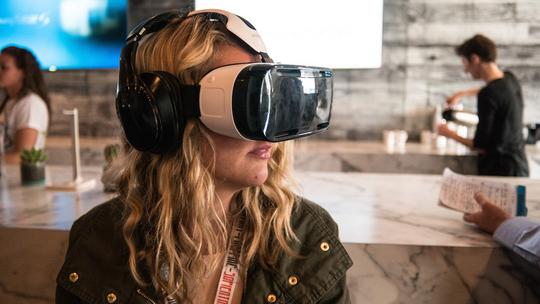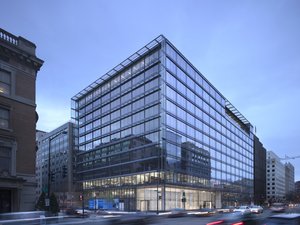

The D.C. area is in an arms race with a number of other U.S. metropolitan areas to become a hub for virtual reality innovation and entrepreneurism. As each region works to position itself for the consumer VR “revolution,” a number of moves must importantly still be made to keep up momentum, locally.
“Virtual reality has been around for many years, and is now finally coming into the mainstream. This is an exciting time to be part of this growing industry, after many years of being an exclusive, small market,” Yuval Boger, CEO of Columbia, Md.-based VR firm Sensics, told DC Inno.
Because of a proximity to the federal government, in addition to a cohort of rising local VR companies and the establishment of the University of Maryland’s VR research center, the District is certainly gaining ground.
But more needs to be done, local VR entrepreneurs and startup founders tell DC Inno.
“I think it's important for organizations to look at the long-term impact of VR. The disruptive potential for this technology is huge and companies need to begin looking into this technology now if they don't want to be caught off guard,” Matthias McCoy-Thompson, co-founder of D.C.-based AgoraVR, said.
If the region wants to fully realize its potential in the virtual reality industry, then there must be greater access for companies to funding and a better understanding of the consumer side of the VR space.
Though these challenges are in some ways specific to the region, in other ways they're what the entire burgeoning industry is facing.
"Companies need to begin looking into this technology now if they don't want to be caught off guard."
To become a technology hub cities typically need to attract more than just great companies. And in this light, we have spotted some elements where the DMV will need to improve upon.
As Eugene Evans, an advisor to VisiSonics and a former Electronic Arts VP, said, “we need to be ready to run a marathon. The winners will be those that build the fundamental building blocks that will be important for many years to come.”
Access to capital
In the past, institutional investors have generally—and pragmatically—ignored the still-young virtual reality market because of its obvious unproven track record related to return on investment.
The D.C. area is typically seen as a more conservative venture capital town than New York, Los Angeles, Seattle and most notably, Silicon Valley/San Francisco. And while this may be unsurprising to some, the degree to which “conservative” investment influences niche industries can be striking.
Access to capital can sometimes be the difference between realizing the growth potential of a company and closing up shop. As the D.C. area’s class of early stage and medium stage VR companies work to evolve into mature businesses—with a steady stream of clients and aspirations for longterm profitability—the availability of capital will be critical.
The founders of perhaps the area’s two most mature VR companies, Sensics and College Park-based true 3D audio developer VisiSonics, spoke to DC Inno about the challenging atmosphere they have faced in the past when it comes to raising funding for their businesses.
VisiSonics CEO Gregg Wilkes said that though he expects to raise a roughly $2 million Series A round in about three months—representing the company’s first non-seed stage raise—reaching the goal of raising capital has been immensely challenging. “In the end, we don’t need to raise funding from local investors. There’s plenty of interested investors in other parts of the country and we’ve spoken to some,” Wilkes said.
Boger, the CEO of Sensics, said that the “biggest thing missing in the mid-Atlantic region” is institutional investors.
“Virtual reality is usually a mulch-disciplinary trade. To design good VR goggles, for instance, one needs to have expertise in optics, ergonomics, sensors, mechanical design, application software, embedded software and more. There is plenty of local talent in these fields, fueled by local universities and defense contractors, but the truth is that there is a lack of local investment dollars,” Boger told DC Inno.
Interestingly, Sensics, much like VisiSonics, is in the process of raising an approximately $1.5 million round from private investors, according to an SEC filing.
"The biggest thing missing in the mid-Atlantic region" is institutional investors.
Whether these two raises are suggestive, on their own, of a changing local VR investment landscape is unclear. But in responding to the SEC filing spotted by DC Inno, Boger briefly mentioned that the company’s existing investors—which include Longstreet Partners and Athlone Global Security—were “increasingly excited about the potential of VR.”
Evans, however, said that recent improvements being made when it came to local VR technology investment came with a silver lining. “Silicon Valley, Los Angeles and other regions have the advantage of greater comfort with consumer facing companies. This is much less common in the DC area,” Evans told DC Inno. "We are very early in VR adoption. We need to get more comfortable with companies pursuing B2B models with results that are consumer facing."
Understanding the consumer shift
The upcoming launch of a series of affordable and high-quality headsets via Sony, Oculus, Microsoft and HTC/Valve are changing the market dynamic, as they allow more people to experience what VR has to offer than ever before.
"As with the Internet, a great deal of early VR innovation was driven by government funding."
Importantly, the price point of VR technology previously made it so large scale adoption was nearly impossible. Yet in early 2016, anyone in the U.S. with roughly $700 will be able to purchase a headset and plug-in to a virtual world.
Today, the reality is that VR is a market with essentially zero installed devices.
Being able to realistically predict what sort of influence widespread VR adoption will have on the market, let alone related industries like video game development, is at the moment unfeasible. But it is at least clear that consumer VR will first, primarily target use-cases like video game, film, application and virtual tours because of the user-centric experiences they pose. This is in contrast to say, industrial, medical and/or design applications that the technology is expected to span into over time.
“As with the Internet, a great deal of early VR innovation was driven by government funding in the DMV region,” Evans said.
Baltimore-based multi-dimensional digital design and development agency Bully Entertainment and startup VR film studio Akibimi Production are among those new local VR companies that are creating intrinsically “consumer-facing” applications.
Akibimi Productions is solely dedicated to the creation of virtual reality films and Bully Entertainment creates promotional 3D experiences for major brands like Mercedes-Benz.
Akibimi Productions founder Dr. Alex Oshmyansky explained that while catering to the defense department is one advantage of being in the DC-area, as compared to San Francisco or Los Angeles, it shouldn't limit the scope of local VR development.
(Above video: Polaris Slingshot - VR Capture Built for Gear VR/Oculus Rift from Bully Entertainment)
In the case of Sensics, founded in 1999, many of it’s early customers were either from the industrial or defense space. These customers provided a unique VR product demand for programs and hardware that could help with things like illustrating complex design schematics and creating complex military training simulations.

Indeed, much of Sensics’ former sales serve as a general indication of the relatively limited clientele list that the industry previous sold exclusively to, especially locally. That being said, it’s possible that the advent and expedited focus on consumer virtual reality, as we discussed prior, can slowly change the lethargic investment atmosphere.
“If the DMV region is to play a role in taking VR innovation to the next level it has to learn how to move the technology from the lab or government contract space into the consumer domain. Here price, availability and the joy and delight of great design are just as critical as great tech. That can be a challenging transition,” Evans added.




